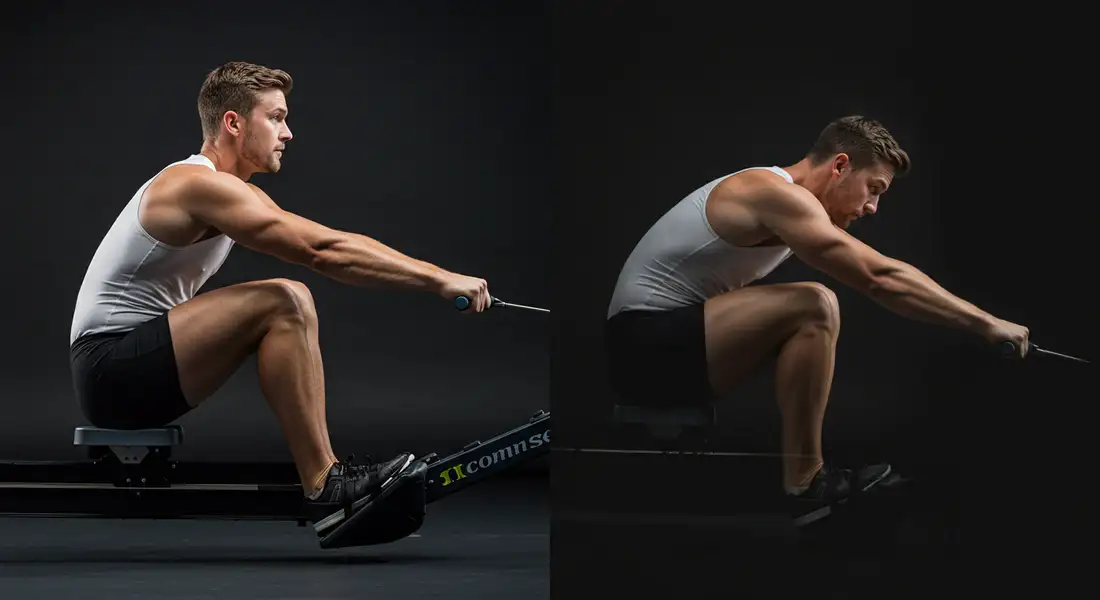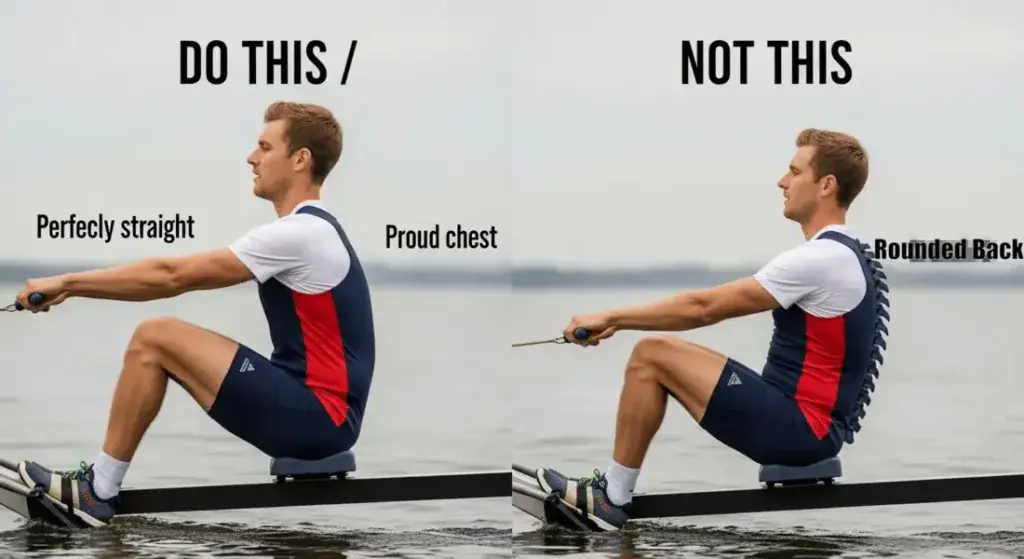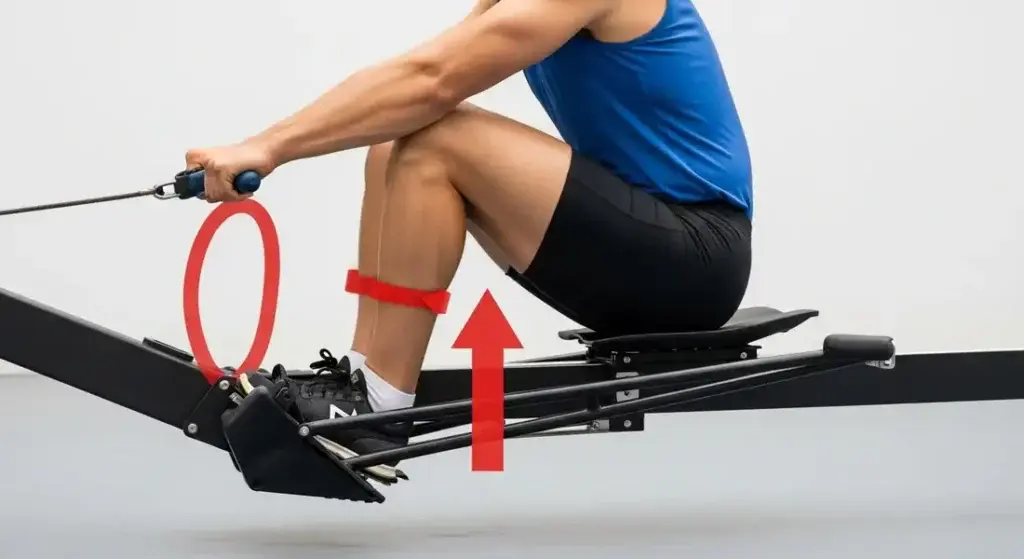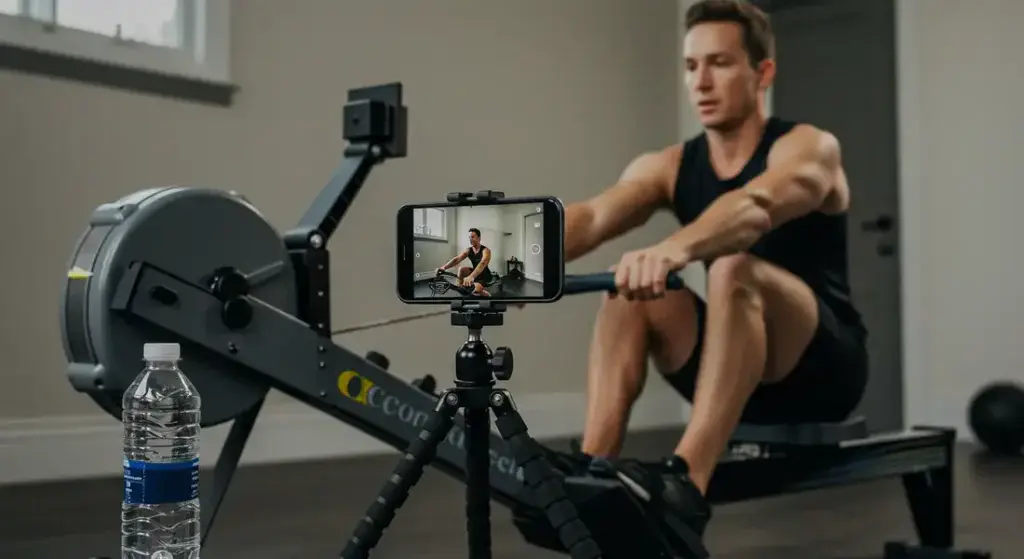Ever feel like your rowing is more “clunky” than “smooth”?
Or maybe you finish a workout and your lower back is talking to you more than your legs are?
If so, you’re not alone.

The rowing stroke is a beautifully complex movement, and nearly every beginner makes mistakes while learning. The good news?
Identifying these common rowing mistakes is the first, most crucial step toward correcting them.
This guide is your personal form-correction toolkit.
We’ll break down the most frequent rowing form mistakes that hold beginners back, explain why they’re detrimental, and give you simple, actionable fixes.
Mastering these corrections will not only prevent injury but will unlock more power, efficiency, and enjoyment from every single stroke.
Before we dive in, ensure you have a solid understanding of the ideal stroke from our Mastering Basic Rowing Technique guide.
Why Correcting Rowing Form Mistakes Matters
Fixing bad rowing habits isn’t just about looking like a pro; it’s about:
- Preventing Injury: Proper form protects your spine, shoulders, and knees from unnecessary strain.
- Boosting Power & Efficiency: A correct stroke engages your powerful leg and core muscles, generating more speed with less wasted effort.
- Increasing Endurance: When you’re efficient, you don’t fatigue as quickly, allowing for longer, more effective workouts.
Let’s dissect the most frequent offenders.
Mistake #1 – The Back-First Pull (Using Your Back and Arms Too Early)
This is arguably the most common and power-sapping of all beginner rowing mistakes.
- The Problem: You initiate the Drive by leaning back and pulling with your arms, instead of pushing powerfully with your legs.
- Why It’s Bad: Your legs are the strongest muscles in your body. Starting the stroke with your back and arms is like trying to push a car with your hands instead of your legs—it robs you of immense power and puts significant strain on your lower back and arms.
- The Fix: The “Legs First” Mantra.
- Mindset: Think “Legs -> Core -> Arms.” Say it out loud.
- The Drill: Practice “legs only” rowing. Sit at the Catch, keep your arms straight and your core angle fixed, and just push with your legs. Feel them do all the initial work. This builds the mind-muscle connection.
Mistake #2 – The Slump (Rounding Your Back)

- The Problem: You slouch at the Catch, allowing your spine to curve into a “C” shape, and maintain this rounded posture through the Drive.
- Why It’s Bad: This is a direct route to lower back pain. A rounded spine cannot be properly supported by your core muscles, placing dangerous compressive forces on your spinal discs.
- The Fix: The “Proud Chest” Cue.
- Mindset: From the moment you sit down, think “sit tall” and “proud chest.”
- The Action: Hinge forward from your hips, not your waist. Imagine your torso is a single, solid plank from your hips to your shoulders. Engage your core muscles as if you’re about to be lightly punched in the stomach—this supports your spine.
Mistake #3 – The Slide Shooter (Shooting the Slide)
- The Problem: Your butt slides backward on the seat well before your shoulders and the handle begin to move. Your legs extend, leaving your upper body behind.
- Why It’s Bad: This completely disconnects your powerful leg drive from the rest of the stroke. Your back is then forced to do a sudden, jerky movement to catch up, putting it at risk.
- The Fix: The “Connected Push.”
- Mindset: Think of your body as a solid unit. Your shoulders and hips should move away from the flywheel at the same time during the initial push.
- The Drill: Watch yourself in a mirror. Focus on keeping the distance between your shoulders and your hips constant for the first part of the leg drive.
Mistake #4 – The Clunky Handle (Bending Knees Too Early on Recovery)

- The Problem: On the return journey (the Recovery), you bend your knees before your hands have passed them.
- Why It’s Bad: It breaks the smooth rhythm of the stroke. You’ll have to lift the handle up and over your knees, which is inefficient and feels awkward.
- The Fix: The “Arms-Core-Legs” Recovery Sequence.
- Mindset: Burn this order into your brain for the return: 1. Arms extend fully. 2. Body hinges forward from the hips. 3. Then, and only then, do your knees bend.
- The Drill: Practice pause drills. At the Finish, pause for a second. Then, extend your arms and pause again. Then, hinge your body forward and pause. Finally, bend your legs. This breaks down the sequence and builds the correct muscle memory.
Mistake #5 – The Over-Reacher (Leaning Too Far Back or Forward)
- The Problem: At the Catch, you over-compress by leaning too far forward. At the Finish, you lean way too far back, past a stable 11 o’clock position.
- Why It’s Bad: Overreaching forward puts you in a weak position to start the drive. Leaning too far back puts huge strain on your lower back and core and wastes energy.
- The Fix: The “1 o’clock to 11 o’clock” Rule.
- Mindset: Imagine a clock face. At the Catch, your torso should be at a 1 o’clock forward lean. At the Finish, you should be at a stable 11 o’clock backward lean. No further!
- The Action: Engage your core at the Finish to act as a “brake,” preventing you from over-leaning.
Mistake #6 – The High Damper Habit (Setting Resistance Too High)
- The Problem: You immediately set the damper on an air rower to 10 (or the resistance on a magnetic rower to max), thinking higher is always better.
- Why It’s Bad: This is one of the most misunderstood rowing machine mistakes. A high damper doesn’t equal more resistance; it just feels heavier, like rowing a slow, heavy barge. It encourages bad form because you have to strain to move the handle at all, often leading to using your back too much.
- The Fix: Find Your Sweet Spot.
- Mindset: Resistance is generated by your effort, not the machine’s setting.
- The Action: Start with a lower damper setting (3-5 on a Concept2 is standard for most people). This feels more like a sleek racing shell and promotes better technique, allowing you to generate power through speed and form.
Mistake #7 – The Death Grip & Hunched Shoulders
- The Problem: You grip the handle for dear life, and your shoulders creep up towards your ears.
- Why It’s Bad: This creates unnecessary tension in your hands, forearms, traps, and neck. It’s a massive waste of energy and can lead to aches and blisters.
- The Fix: Relax and Hang.
- Mindset: Your hands are just hooks. Your arms are just ropes connecting your body to the handle.
- The Action: Hold the handle with a relaxed grip, primarily with your fingers. At the Catch, actively think “shoulders down and away from ears.”
Mistake #8 – Rushing the Recovery
- The Problem: You fly forward on the slide as fast as you drove back.
- Why It’s Bad: The Recovery is your time to rest and breathe! Rushing it exhausts you, kills your rhythm, and doesn’t allow you to set up properly for the next powerful Catch.
- The Fix: The “1-Count Drive, 2-Count Recovery” Rhythm.
- Mindset: The Drive is explosive; the Recovery is patient.
- The Action: Aim for a ratio of roughly 1:2. If the Drive takes one second, the Recovery should take two. This controlled return will dramatically improve your endurance and overall performance.
Your Proactive Toolkit for Better Form

Knowing the mistakes is half the battle. Here’s how to actively fix them:
- Slow Down: You can’t fix form at top speed. Row slowly, focusing entirely on the sequence and feel.
- Use a Mirror or Your Phone: Visual feedback is priceless. Set up a mirror to your side or film yourself with your phone. Many coaches, like those affiliated with U.S. Rowing, champion video analysis as a key tool for improvement.
- Practice Drills: Isolate parts of the stroke with drills like “legs only” or pause drills to build muscle memory.
- Focus on One Fix at a Time: Don’t try to correct everything at once. Dedicate your next workout to fixing just one of these common rowing mistakes.
FAQs – Common Rowing Form Concerns
- Q1: My lower back always hurts after rowing. Which mistake am I most likely making?
- A: The most common culprits for lower back pain are rounding your back (the “Slump”) instead of keeping it straight, or using your back too early in the Drive instead of letting your legs do the initial work. Focus on maintaining a “proud chest” posture and initiating every single stroke with a powerful leg push.
- Q2: How can I tell if my form is correct when I work out alone at home?
- A: Filming yourself is the best way. Prop your phone up to get a side-on view of your full stroke. Watch the video back and compare your positions at the Catch, Drive, and Finish to guides and videos of correct form. You will be surprised what you can spot in your own technique.
- Q3: Should I try to fix all my rowing mistakes at once?
- A: It’s best to focus on one, maybe two, corrections at a time. Trying to fix everything at once can be overwhelming. For example, dedicate one entire workout to “keeping my back straight,” and another to “making sure my arms are last to pull.” Once a fix starts to feel natural, move on to the next.
Conclusion – From Mistake to Mastery
Every single person who has ever sat on a rowing machine has made these mistakes.
Viewing them not as failures but as opportunities for improvement is the key to progress.
By becoming aware of these bad rowing habits and consciously applying the fixes, you will build a strong, efficient, and safe technique.
This foundation will allow you to confidently tackle any simple rowing workout and truly enjoy your journey to becoming a proficient rower.
What rowing mistake have you struggled with the most?
- Share your “aha!” moments and questions in the comments below!
Ready to solidify your good habits?
- Go back and review our complete Mastering Basic Rowing Technique guide.
- Return to the main Beginners Guide to Rowing Machines for a full overview.
